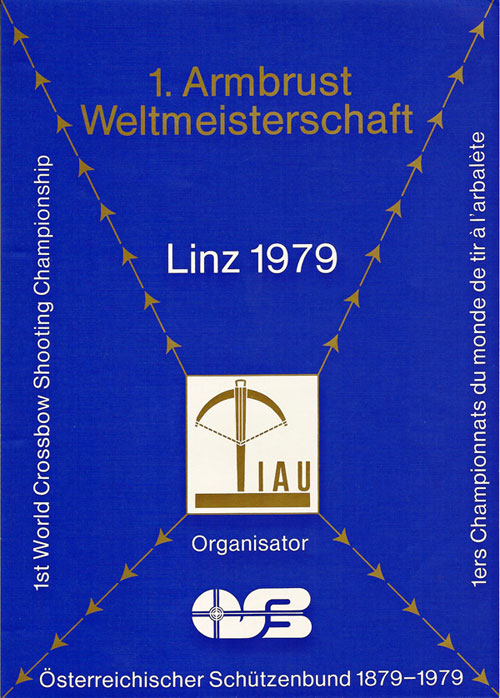
Poster from Linz.
1st IAU Match Crossbow World Championships, Linz, Austria
August 29 - September 1, 1979
USA Team Members:
Thurston Banks
William Boyle
David Kimes
Bruce Meredith
James Meredith
Richard Neill
Medal Results:
David Kimes - Bronze - 30m Combined
David Kimes - Silver - 30m Standing
David Kimes - Bronze - 30m Kneeling
Results:
10m Standing 40 shots:
Team:
1. France 1502
2. Austria 1499
3. Germany 1496
4. USA 1483 (James Meredith 373, Thurston Banks 370, David Kimes 370, Bruce Meredith 370)
9 teams
Individual:
1. Fink Austria 383
2. Bury France 380
3. Hillenbrand Germany 379
4. Cooper Great Britain 378
5. Recht France 376
6. Kuplweiser Germany 375
7. Toillie France 374
8. Hottowy Austria 374
9. Mattle Switzerland 374
10. James Meredith USA 373
15. Thurston Banks USA 370
16. David Kimes USA 370
17. Bruce Meredith USA 370
42 competitors
30m Standing 30 shots:
Team:
1. GERMANY 1395 (Horneber 287, Kusterman 279, Kuplweiser 279, Sichert 276, Krenn 274)
2. FRANCE 1366 (Bury 281, Toillie 276, Hecht 276, Maquin 271, L'Helgouach 262)
3. SWITZERLAND 1352 (Nipkow 292, Grossglauser 273, Strasser 269, Fretz 258, Thoma 258)
4. AUSTRIA 1346 (Windhoffer, P. 277, Windhoffr, G. 272, Mesaric 268, Fink 265, Hottowy 264)
5. USA 1331 (Banks 280, Meredith, B. 277, Kimes 273, Meredith, J. 270, Boyle 231)
8 teams
Individual:
1. Kuplwieser Germany 289
2. David Kimes USA 285
3. Krenn Germany 285
4. Nipkow Swiss 285
5. Horneber Germany 285
6. James Meredith USA 284
7. Toillie France 282
8. Kusterman Germany 280
9. Recht France 277
10. Grossglauser Swiss 277
23. Thurston Banks USA 260
24. Bruce Meredith USA 260
49 competitors
30m Kneeling 30 shots:
Team:
1. GERMANY 1457 (Kuplwieser 294, Horneber 293, Kusterman 292, Krenn, 292, Sichert 286)
2. SWITZERLAND 1452 (Grossglauser 294, Strasser 292, Nipkow 290, Thoma 288, Eigenmann 288)
3. AUSTRIA 1430 (Mesaric 290, Fink 288, Hottowy 287, Windhoffer, P. 287, Windhoffer, G. 278)
4. FRANCE 1429 (Bury 292, Toillie 291, L'Helgoualch 287, Maquin 281, Recht 278)
5. NETHERLANDS 1420 (Graumans 294, Braat 288, Ermens 283, Maryniessen 278, Jansen 277)
6. USA 1394 (Kimes 294, Meredith, J. 284, Meredith, B. 282, Banks 277, Boyle 257)
8 teams
Individual:
1. Nipkow Switzerland 298
2. Kustermann Germany 297
3. David Kimes USA 296
4. Krenn Germany 296
5. Kuplwieser Germany 295
6. Strasser Switzerland 294
7. Toillie France 294
8. Graumans Holland 294
9. Fretz Switzerland 293
10. Sichert Germany 293
22. James Meredith USA 286
30. Thurston Banks USA 286
33. Bruce Meredith USA 283
40. William Boyle USA 276
50 competitors
30m Combined :
Team:
1. Germany 2852 (Horneber 580, Kuplweiser 573, Kustermann 571, Krenn 566, Sichert 562)
2. Switzerland 2803 (Nipkow 582, Grossglauser 567, Strasser 561, Fretz 547, Thoma 546)
3. France 2795 (Bury 573, Toille 567, Recht 554, Maquin 552, L'Helgoualch 549)
4. Austria 2776 (Windhofer, P 564, Masaric 558, Fink 553, Hottowy 551, Windhofer, G 550)
5. Netherlands 2739 (Graumans 564, Marynissen 555, Braat 546, Jansen 542, Ermens 532)
6. USA 2725 (David Kimes 567, Bruce Meredith 559, Thurston Banks 557, James Meredith 554, William Boyle 488)
8 teams
Individual:
1. Kuplweiser Germany 584
2. Nipkow Switzerland 583
3. David Kimes USA 581
4. Krenn Germany 581
5. Kurstermann Germany 577
6. Toillie France 576
7. Horneber Germany 576
8. Strasser Switzerland 571
9. James Meredith USA 570
10. Grossglauser Switzerland 570
17 competitors
in final
Official Results Bulletin as a .PDF document.
Narrative:Upon arrival, Neill elected to not shoot. He felt his experience level was not where he felt it needed to be and did not want to be embarrassed. The team was really hurt when we could not field 6 shooters. It would have made a world of difference if Cramer and Aylward could have broken away from their jobs or other obligations as the USA would have taken medals.
There were 42 shooters in the championship. Nations represented were Austria, France, Germany, Great Britain, Switzerland, Japan, USA, Netherlands, Belgium, Italy, Canada, Israel, Bahrain.
Program:
August 28th, Arrival, Meeting of IAU Technical Committee.
August 29th, Training 10m and 30m. Meeting for Team Coaches. General Meeting of the IAU.
August 30th, Opening Ceremony at the range. 10m World Championship. Then 30m training.
August 31st, 30m Team World Championship.
September 1st, 30m Individual Standing, 30m Individual Kneeling, Victory Ceremony.
Thus was the result of a first year struggle to get an organization together. Kimes was brilliant and eventually became IAU Vice President - Americas. Everyone was learning.
Behind the scenes story: Bruce Meredith still has nightmares about his experience and lesson learned the hard way. The 30 meter range had over 50 firing points, maybe 70. As with most ranges the first firing points are used by the locals when they practice and probably the first 10 or 15 are used in a local match. No one is going to lug the bow and gear 30 yards away to shoot on the far targets. Thus, the last 10 or 15 points on the range are probably rarely used. So if you think about it, this old range probably has problems with the functioning of the rarely used high number points. That really hurt Bruce Meredith, the last shooter on the end.
There was a soldier sitting down range at 30 meters, right at the far target. He was sitting in a folding chair facing down the line looking toward point one. Bruce thought his job was to go pick up bolts that fell out of the leads. In reality, the shooter's coach is the person to go down to retrieve his shooter's bolt if it drops to the ground en route or at the end location. That soldier was supposed to be checking that the carriers went into full battery at the end of the wire. He was dozing off asleep most of the time on the sunny day.
Bruce shot standing his first string: 10-6-8-10-9-9-10-10-9-9-10 = 91. He was relaxed and holding well. He did not call the 6, but it is maybe not a good call. He took a break after ten, sat down, relaxed, snapped a few photos down range and got back to shooting. He was feeling good. The second string was 10-10-9-10-9-10-10-9-10-9 = 96. Going to do well here. Last string 10-9-9-8-2-1-10-9-7-8=73. Total 260.
What was happening on the last string, and maybe the first, involved the carrier, but that was unknown to Bruce, an inexperienced crossbow shooter. The trajectory of the bolt is very high and slow and it comes down into the target at a good angle. The depth perception of a human is not good enough to see if the target has gone into final stop. If the electric motor shuts off too soon , the target ends up four to six inches short of the end which is a serious problem. That would make a falling bolt hit high, real high, like 1 ring. When he got the 8 Bruce adjusted the sight, rather than believing his call. He kept going high and low and clicking to no good success. When the bolt hit the 2 ring high, he took the sight off the bow and put it in a different notch. When it hit the 1 ring he also did wild stuff with the sight. He fought elevation the rest of the string and in kneeling too. He did not know what the hell was going on, never thinking it was the carrier, but blaming the sights and bow. Of course, the old timer spectators behind him knew what the hell was going on and even if the American didn't have a clue.
What he learned much later, actually years later from David Kimes, who learned it from someone, was that the local expert shooters tie a string or ribbon around the wire at their feet, when the target is fully at the 30 meter end. The string travels with the wire. When the target goes down range each shot, you better look down at the string to make sure it is where it should be in front of your feet. Otherwise reach down to the wire and tug on it to get the string where it should be, indicating you have moved the target to the end, before you shoot again. That problem could have been the 6 and 8 on the first series. It was certainly the problem with the 2 and 1 ring hits. Bruce is certain the range malfunctioning possibly cost him a standing medal in the first IAU World Crossbow Championship.
Photos:
Thanks to Bruce Meredith and Thurston Banks for the images!

Poster from Linz.
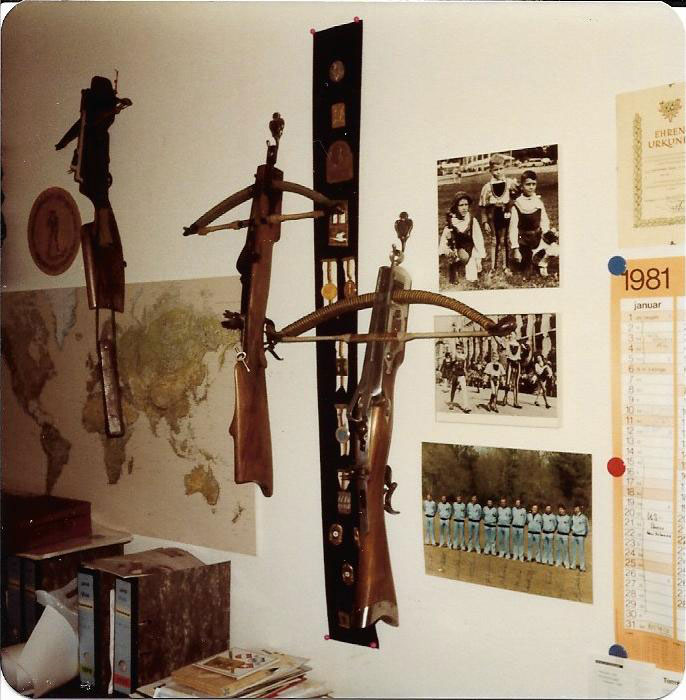
Huber's office in Ulm, Germany.
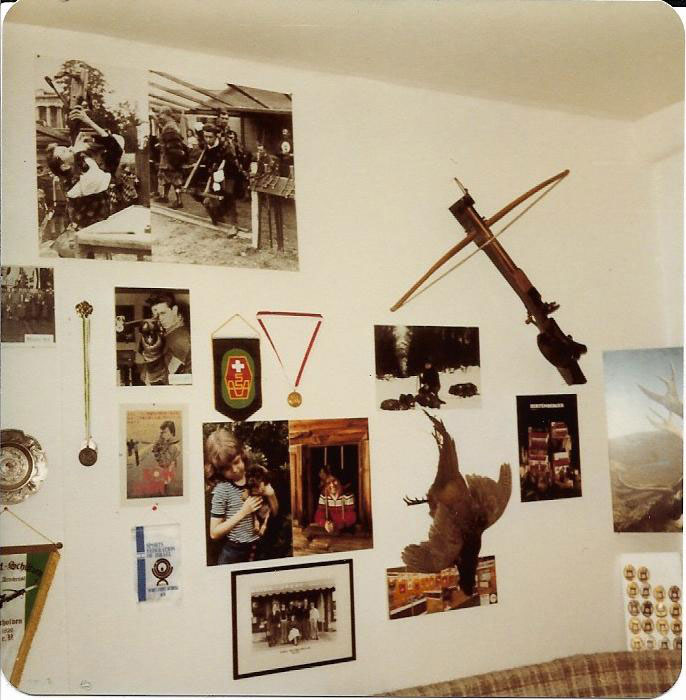
Huber's office in Ulm, Germany.
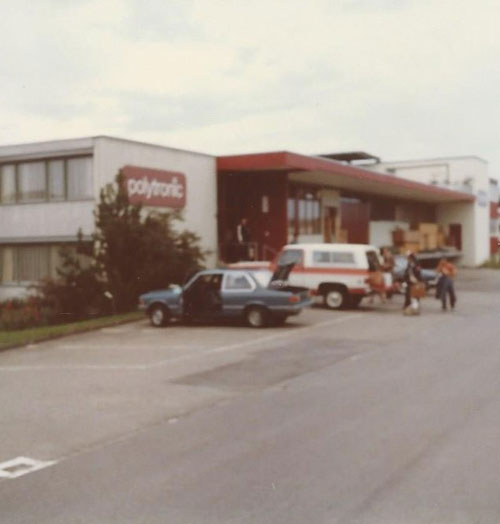
Arriving at POLYTRONIC AG in Muri,Switzerland before going to Linz, Austria..
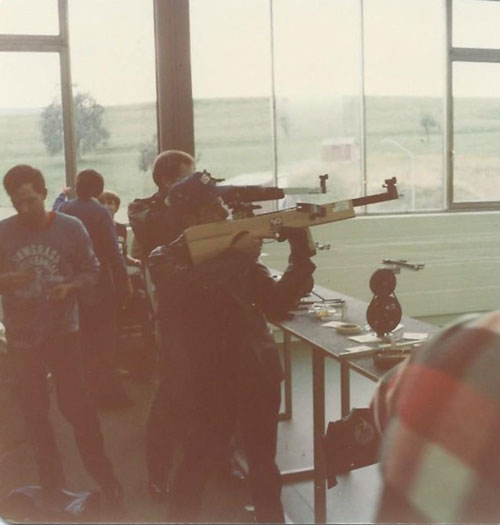
Getting a little 10m crossbow training in at POLYTRONIC AG.
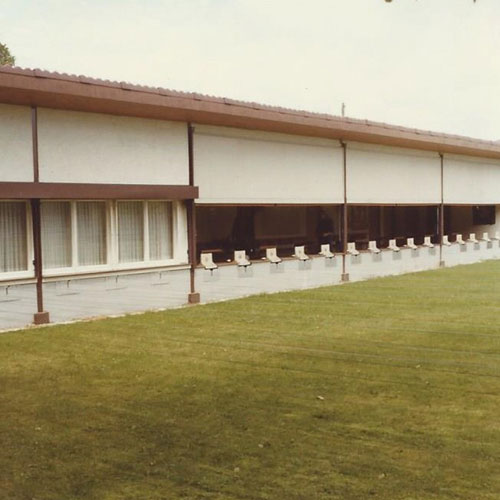
Dietlikon, Switzerland crossbow range.
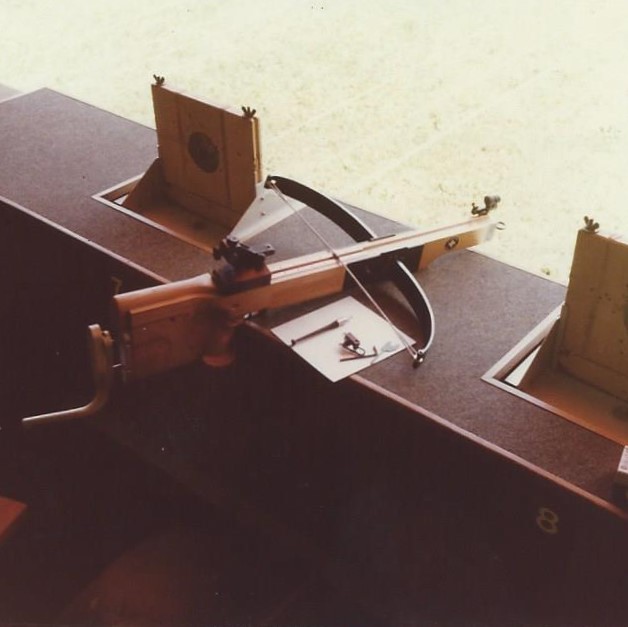
Dietlikon, Switzerland crossbow range.
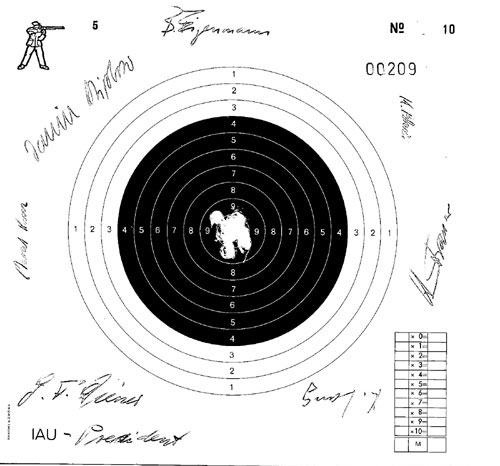
Thurston Banks 30 meter target.
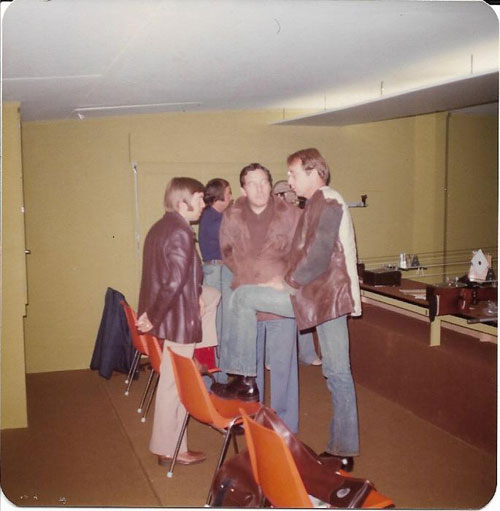
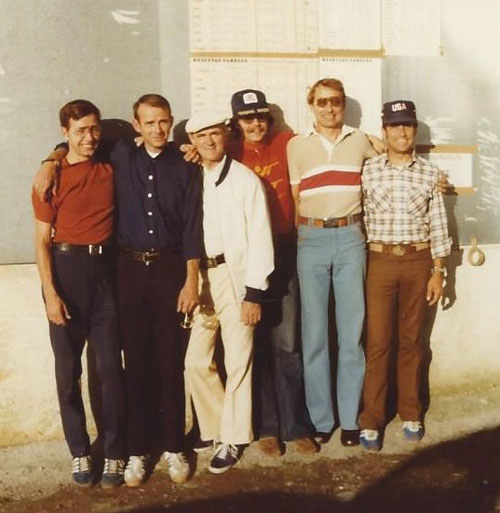
USA team L to R: James Meredith, Thurston Banks, Dick Neill, William Boyle,
Bruce Meredith, David Kimes.
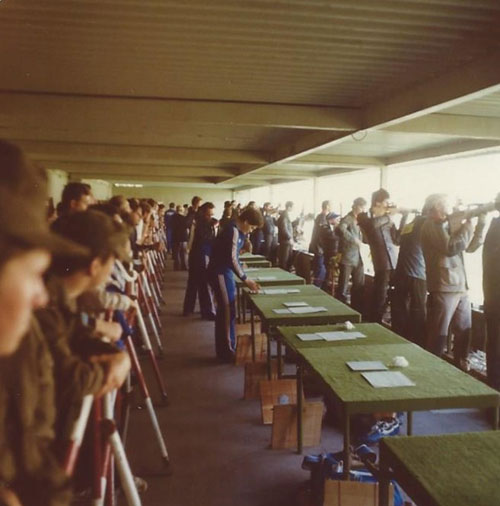
Firing line during standing.
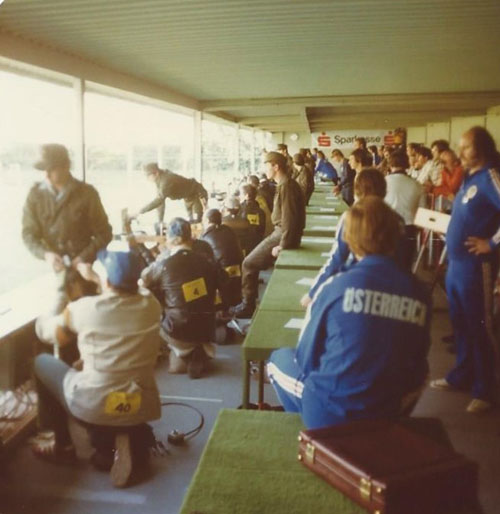
Firing line during kneeling.
.jpg)
Danube River
.jpg)
Danube River
.jpg)
Linz Clubhouse
.jpg)
Linz Clubhouse
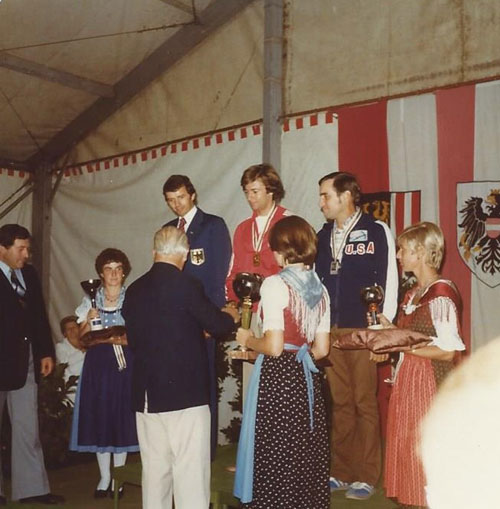
David Kimes on the awards stand for 30m Kneeling.
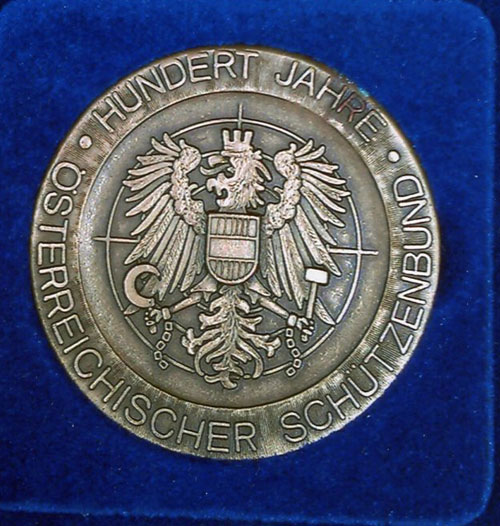
Participation momento.
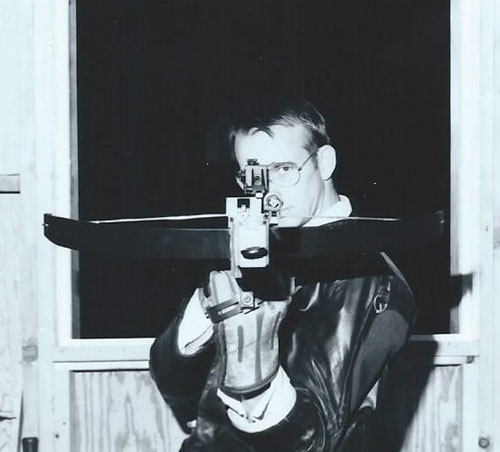
Thurston Bank shooting standing.
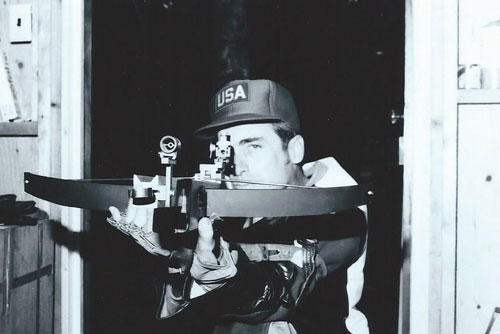
David Kimes shooting kneeling.
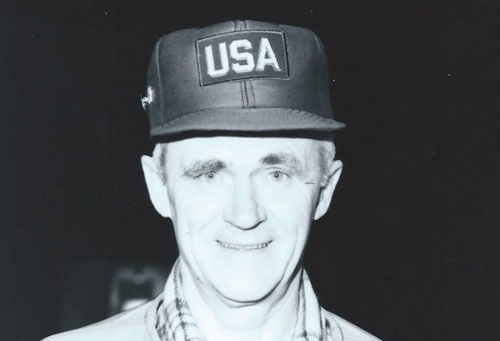
Richard Neill

Scorecard for Bruce Meredith - 10 Meter.
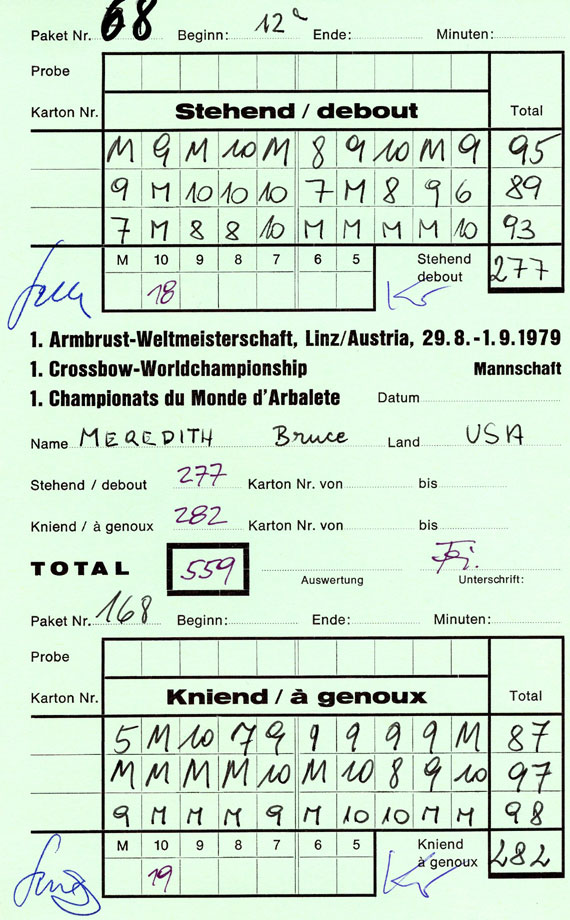
Scorecard for Bruce Meredith - 30 Meter Team.
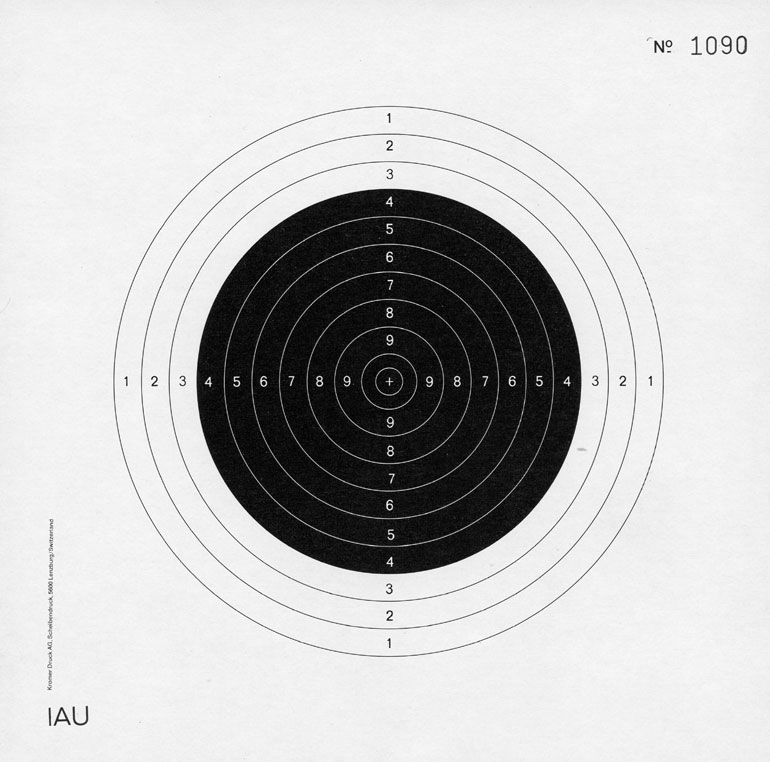
30 Meter IAU target.
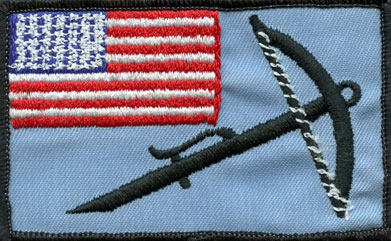
US Armbrust Association patch used in Linz.
If you have any photos or results, please email them to the webmaster Ray Carter at raypcarter@comcast.net.